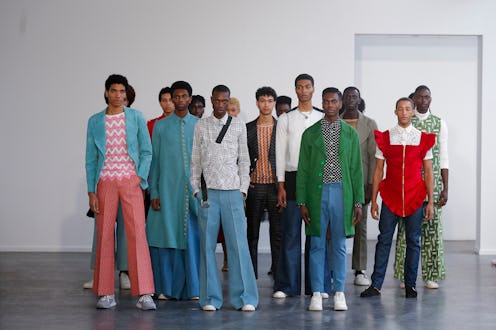(Fashion)
The Black In Fashion Council's NYFW Showroom Boosted Visibility For These Emerging Designers

On a fundamental level, the raison d'etre for Fashion Week is to present clothes that capture the current moment and consider the future. That said, this season's NYFW came with huge responsibility. Amidst the explosion of racial justice issues, a still-raging pandemic, and a blazing American West, the occasion had to reckon with our reality in order to be adequate, let alone exceptional. The Black In Fashion Council, which launched this June, chose to turn this moment into opportunity — creating a Discovery Showroom for emerging Black designers to be seen and heard.
In addition to the usual (and, amidst COVID-19, unusual) programming, the showroom gave designers like Kenneth Nicholson and Theophilio a physical, "IRL" space at Spring Studios at which they could show their designs. With IMG as a sponsor, the showroom helped to remove some of the barriers to entry that have guarded NYFW in years past — chief among them all being cost. According to a 2019 article by Vogue Business, showing at NYFW can cost upwards of $300,000 — a tall order for emerging labels, many of whom are already struggling to stay profitable amidst the pandemic. "My biggest barrier was financial," Aaron Potts of APOTTS tells TZR, when asked about past challenges in showing at the event. "This showroom space has allowed for funds to be diverted from paying for a space to actually creating a good collection."
The initiative also gave designers access to the BIFC's widening network, including editors, stylists and executives that it may have been challenging to get in front of prior. "The connections to PR professionals has aided me in reaching people I had only dreamed of reaching," says Potts. "I had a couple of high-level stylists and editors tell us that the outreach [from BIFC] led them to me. That is amazing." Undra Duncan, designer behind Undra Celeste, had a similar experience: "Prior to the showroom, it was a challenge to get major publications to view my collection without some other incentive," she tells TZR. "Although I have been featured before, this was the first time they came specifically to just see my collection and what I had to offer as a designer. The response was amazing."
The Black In Fashion Council, which is spearheaded by Teen Vogue editor-in-chief Lindsay Peoples Wagner and public relations specialist Sandrine Charles, premiered the tentpole program this season. To the organization, the showroom is not just about beautiful clothing — its intention is also to center authentic conversations on diversity and inclusion, while installing equity amidst fashion's biggest season. "There was a palpable excitement that came across in discovering not only emerging voices in fashion but an excitement that came from seeing Black design talent being championed," says Designer Kenneth Nicholson to TZR. "Having the companion discussion panel was a nice way to bring meaningful conversation to the fore."
Potts seconds this notion, explaining the dialogue that occurred needed to be had. "The function of the BIFC is to create a realignment so that the playing field becomes more level, allowing for Black talent to have equal footing and opportunities," says Potts. Duncan adds: "[The BIFC Showroom] allows for editors to see that a diverse offering does not mean a lesser offering. Eventually, we will be known as just great designers, not 'Black' designers."
To keep abreast of what's next for the BIFC, be sure to follow its Instagram page for more updates.
This article was originally published on